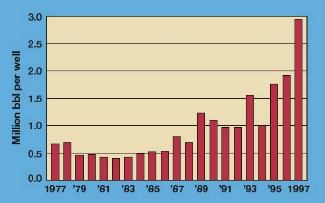What's happening in exploration
World seismic report, discovery efficiencies soarSince World Oil does not usually forecast the seismic industry, a brief report seems in order. According to World Geophysical News, which is the source for all data presented herein, there were 427 working seismic crews in the world in early January 1997, with 104 of these in the U.S. By January 1998, the number of working crews worldwide had increased to 452, while the U.S.’ share had increased to 126. At the end of the third quarter 1998, crew counts began to gradually fall. As of January 1999, the world crew count had dropped to 399, an 11.7% decrease from a year earlier. The U.S. crew count also declined 4.8%, to 120. In terms of crews working worldwide, the five most active seismic companies in January 1999 were Western Geophysical (84), CGG (46), Geco-Prakla (41), PGS (28) and Veritas DGC (23). The U.S. remains the most active country, with about 30% of the world’s seismic crews, followed by Africa and Latin America, tied with a 14% market share each, and Europe, with an 11% share (January 1999 figures). Most world (excluding the U.S.) activity takes place onshore, at about a 78% of the total, while 22% occurs offshore. Most U.S. surveys are also inland, but at about a 60% to 40% onshore-to-offshore ratio — the higher offshore number due to Gulf of Mexico activity. One last item of interest is the number of 3-D vs. 2-D surveys. The ratio of current, worldwide 3-D to 2-D surveys (outside the U.S.) was 116/105, or roughly 1 to 1. For the U.S., the ratio was 105/14, or about 8 to 1. The explanation for the difference is that in a mature exploration area like the U.S., 3-D is essential. There was only one 4-D survey reported in January. World Oil’s best guess for 1999 is that it could be similar to 1998 in terms of seismic crew count, i.e., expect another small decrease. However, due to an expansion in capacity throughout 1998, especially in vessels, there may be a greater increase in the number of inactive crews. Seismic should fare better than most oil-patch industries because of its long-term goals, and because its cost is often compared to the cost of a dry hole: spend a buck and save two. TransTexas extends discovery. TransTexas Gas Corp. said that its fourth well, State Tract 330-1, in Eagle Bay field in Galveston Bay, Texas, indicated the field would extend into a second major fault block. The 17,000-ft MD well encountered 83 ft of net pay and porosity up to 30%. The 330-1 well location was based on new 3-D seismic data and directionally drilled under Galveston Bay from land. Fifteen additional drilling locations were also identified from the new 3-D data. The first three Eagle Bay wells currently produce 55 MMcf gas and 9,000 bbl of condensate per day. The company’s Trout Point prospect on the east shore of Galveston Bay ran into pressure-control problems. The Sheldon 1 well, a vertical sidetrack of State Tract 197-1, started to flow gas while drilling. During pressure-control operations, the drillstring below 14,000 ft was lost. Currently, the well is being sidetracked to a planned depth of 22,500 ft. Exponential growth. An interesting chart from the U.S. EIA, shown below, helps explain why U.S. reserves are increasing. The onslaught of new technologies is allowing proved crude reserves per exploratory well to grow at an exponential rate. Enhanced recovery technologies translate into higher recovery factors, which in turn creates huge increases in asset value.
Nova Scotia seeks bids. The Canada-Nova Scotia Offshore Petroleum Board will seek bids on 5.4 million acres near Sable Island. The 20 parcels stretch from Cape Breton Island through Sable Island and on southward. The board said it issued the call to due to interest from oil companies. Nova Scotia Premier Russell MacLellan said the increased interest is partly attributable to the establishment, last August, of generic royalty rules that cover all new offshore activity. The Premier called the area "the most exciting energy play in Canada today." Awards will be based solely on the amount of money proposed for exploration during the first five-year period of the license. If a well is drilled during the first five years, the term of the license will be extended to nine years. There is a $1-million minimum bid. Companies will be able to claim up to $450,000 per day for a jackup rig, and $600,000 per day for a semi-submersible rig. Interested companies will have until April 29, 1999, to place their bids. Huge 2-D survey. Schlumberger Geco-Prakla and TGS-NOPEC announced completion of the largest 2-D seismic survey ever acquired. The joint venture between the two companies began in October 1995, and was completed three years later. The final shipment of processed data was delivered to participating oil companies on Dec. 31, 1998. The non-exclusive survey comprised 99,000 km of 2-D data in deepwater areas of the Gulf of
Mexico. Five seismic vessels and more than 450 employees of both companies participated in
the survey. Copyright © 1999 World
Oil |




